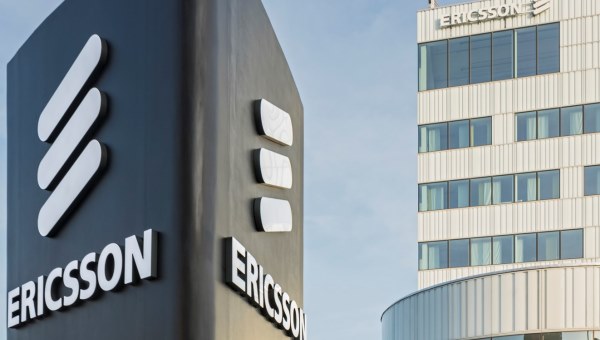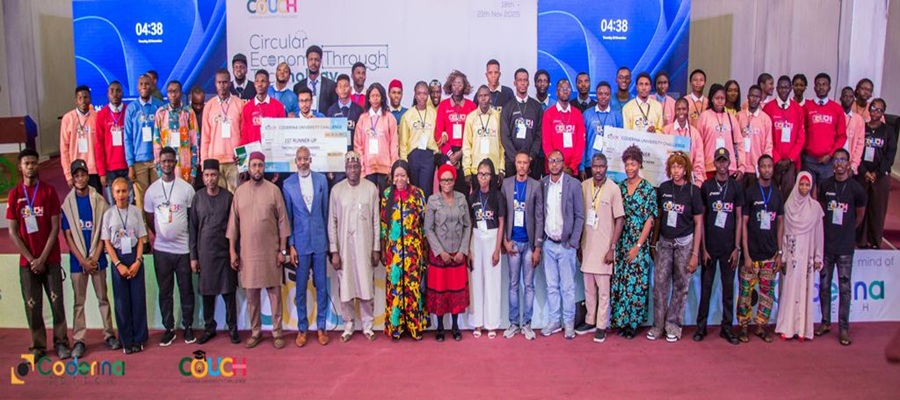Telecom
Ericsson Commits to Net Zero by 2040 in 2021 Sustainability and Corporate Responsibility Report

Ericsson delivered on its sustainability targets and made a series of new commitments in 2021. The company put a particular focus on energy performance and strengthening its ambition to reach Net Zero across its value chain by 2040.

In 2021 Ericsson introduced a new vision to improve lives, redefine business and pioneer a sustainable future. Building on decades as a sustainability pioneer, the company has made a strong commitment to fulfilling this vision through its own efforts and through working across and beyond the ICT ecosystem.
This focus is reflected in Ericsson’s latest Sustainability and Corporate Responsibility Report, which highlights its 2021 performance across the areas of responsible business, environmental sustainability and digital inclusion.
“Our sustainability-driven solutions and partnerships create real impact for our customers and our stakeholders,” says Heather Johnson, Ericsson’s Head of Sustainability and Corporate Responsibility.
“But they also create value for society, whether by enabling the reduction of emissions across industries, creating more energy-efficient networks or helping to bridge the digital divide. We made significant progress towards our sustainability goals in 2021, and we are now setting even more ambitious targets for the future.”
Performance and highlights
Net Zero: In 2021 Ericsson set a long-term ambition to be Net Zero by 2040 across its value chain. To meet this ambition, Ericsson will work towards 1.5°C aligned climate targets set by the Paris Agreement.
The first major milestone is to achieve Net Zero emissions from the company’s own activities by 2030 – as well as reducing emissions by 50 percent in its portfolio and supply chain also by 2030.
Energy performance: To meet customer expectations and help the telecom industry reach Net Zero, Ericsson has developed innovative solutions that enable operator networks to use as little energy as possible while managing expected growth in data traffic, meeting the needs of both current and future 5G networks.
In 2021, Ericsson achieved 36% energy savings from delivered Ericsson Radio System radios versus the legacy portfolio, surpassing the company’s approved Science Based Target of 35 percent one year ahead of schedule.
During 2021, Ericsson also launched a series of ultra-light Massive MIMO radios that are 10 percent more energy efficient than the previous generation.
Digital inclusion: The digital divide continues to be a key challenge to global economic development with roughly 2.9 billion people still offline. With innovative technologies and services, Ericsson and its partners and customers are pioneering new ways to connect societies and improve lives.
In 2021 Ericsson continued its partnership with UNICEF in support of the Giga initiative, helping to map schools and assessing their connectivity in 35 countries by the end of 2023.
Ericsson also made a commitment to positively impact one million children and youth by 2025 by providing access to digital learning and skill development programs as part of the World Economic Forum-aligned EDISON Alliance 1 Billion Lives Challenge.
Corporate responsibility: Ericsson continued its focus on health, safety and well-being in 2021, including a robust COVID-19 response that included a focus on employee mental health and access to vaccines in places where they were not easily accessible.
In 2021 there was an increase in work-related fatalities compared to 2020, in contrast to the decreasing trend of recent years. The company has declared this unacceptable and is more committed than ever to Target Zero – a goal of zero fatalities and lost workday incidents.
Ericsson launched its revised Code of Business Ethics, which defines both the company’s ethical principles and its expectations of responsibility across the value chain. The company also added integrity as one of its four core values as well as publishing a report on the human rights impact of 5G.
Ericsson’s Sustainability and Corporate Responsibility Report is part of the Company’s Annual Report and externally assured by an independent third party. It is also produced in accordance with GRI Sustainability Reporting Standards and the UN Guiding Principles on Business and Human Rights Reporting Framework.
Ericsson continues to strengthen its radio access network (RAN) portfolio with solutions that address the 5G rollout and sustainability goals of communications service providers. Announced today, the portfolio additions will deliver sizeable energy savings and up to ten-fold capacity increases – with minimal or no added footprint.
Leading the portfolio enhancements is Radio 4490, a dual-band radio that delivers 25 percent lower power consumption and lesser weight compared to the current product. This radio type is compatible with most of the radio sites globally as it supports the main FDD (Frequency Division Duplex) bands being used by many service providers for their 5G deployment.
Ericsson is also launching a high-power version of the new dual-band radio, 4490 HP, which enables up to 50 percent more output power compared to current radios. The two new radios apply passive cooling – reducing power consumption further, as fans are not needed. They are also Cloud RAN-ready.
Per Narvinger, Head of Product Area Networks, Ericsson, says: “We continue to evolve our RAN portfolio with more solutions for smart, slim, and sustainable 5G networks. Our latest innovations will further optimize 5G sites for both purpose-built and Cloud RAN deployments.”
5G rollouts are accelerating across the world, with frontrunners gearing up for the shift to 5G Standalone to drive new consumer and enterprise use cases. Introducing 5G means added spectrum and hardware – which is where Ericsson’s new products play a key role through the ability to raise capacity while slashing power usage – fueling efforts to break the energy curve.
Telecom
COUCH 2025 Grand Finale Highlights Student Breakthroughs, Secures Government Pledge for University Research Commercialization

Coderina Education and Technology Foundation, in partnership with the National Universities Commission (NUC), successfully hosted the Grand Finale of the Coderina University Challenge (COUCH) 2025 at the NUC Auditorium, Abuja.

A cross section of attendees
The event gathered top government officials, university leaders, industry partners, and the ten finalist teams selected from over sixty-two initial entries nationwide.
This year’s challenge, themed “Circular Economy Through Technology” spotlighted the potential of Nigerian university students to develop scalable, tech-enabled solutions that address pressing national issues in sustainability, waste management, energy transition, and the circular economy.
The Grand Finale reaffirmed a consistent message shared across all keynote addresses: Nigeria must accelerate the movement of university research from shelves into practical innovation, commercialization, and industry adoption, a key driver of national development and economic growth.
In his opening address, Mr. Olufemi Niyi, chairman, Coderina Board of Directors, emphasized that university projects must not remain buried in archives.
He highlighted COUCH as a platform proving that research can become functional innovation.
Mr. Niyi called on donors, development partners, and private sector stakeholders to support COUCH as a sustainable national innovation pipeline and encouraged investors to channel resources into skills development and technology innovation among youth.
In his keynote address, Dr. Kingsley Tochukwu, the minister of Innovation, Science and Technology, commended the COUCH programme for its role in moving research “from the shelves to the marketplace,” a key priority under the ministry’s national innovation agenda.
He noted that the initiative exemplifies the type of collaboration and commercialization pipeline needed to unlock Nigeria’s scientific and technological potential.
He highlighted several priority areas critical to advancing the country’s innovation landscape:
“Strengthening Nigeria’s innovation ecosystem through coordinated national frameworks and partnerships; expanding digital innovation pathways to accelerate the adoption of emerging technologies, and building a tech-driven economy that delivers measurable value and global competitiveness”.
The Minister added that “Creating new opportunities for youth innovators, ensuring they are empowered to participate in and drive the innovation economy, are part of the key focus areas of the Ministry
He also expressed the Ministry’s readiness to partner with COUCH, Coderina, and the NUC to incubate and scale these student-led innovations.
Mallam Abdullahi Yusuf Ribadu, the executive secretary of NUC acknowledged the twelve universities nominated for the pilot edition by the commission.
He urged the finalists to use their prize money to advance entrepreneurship and technical skill development, reinforcing the NUC’s commitment to fostering innovation-driven learning across tertiary institutions.
In a remarkable commitment, the Minister donated five million naira to ‘Waste2Light’ from FUT Minna and announced an intention to collaborate with all ten finalist universities to support commercialization.
Dr. Tope Kolade Fasua, special address to the President on Economic Affairs, stated that technology remains the largest driver of global economic growth, stressing that Nigeria’s economic transformation is intertwined with youth innovation.
He commended Coderina and advised for greater visibility and national media outreach; creation of an innovation “museum or archive” for brilliant ideas, and the establishment of centers where theories and research can be turned into products.
He concluded that the future of Nigeria’s economy lies in the hands of today’s young innovators.
Professor Sa’adatu Hassan Liman, special guest at the programme and vice-chancellor, Nasarawa State University, delivering her address on “Sustainable National Transformation,” emphasized the need for stronger industry–university collaborations.
She also emphasized need for entrepreneurial university culture; digital literacy in emerging technologies such as AI, blockchain, IoT; adoption of virtual learning and remote laboratories, and inclusive innovation for underserved communities.
She highlighted AI as a catalyst for reimagining teaching and learning, including teacher retraining and curriculum enhancement.
The competition had two categories of prizes recognizing both technical excellence and public engagement.
Winners of the first category, The Challenge, based on pitch and prototype presentation was Team IMSU – Imo State University , taking home the star prize of ₦5,000,000; 2nd Place winners: Team Neuronaut Nile University Prize, ₦2,500,000, and 3rd Place – Team Waste2light from the Federal University of Technology, Minna: ₦1,500,000.
The People’s Choice Awards winners, based on social media engagement and public voting, are Team ADSU Innovators – Adamawa State Uni.: ₦250,000; 2nd Place -Team Scraplink, Lagos State University: ₦150,000, and 3rd place – Team Circle from the Federal University of Technology, Akure, took home ₦100,000.
Giving COUCH overview, Ms. Christiana Anthony, the Project Lead, reaffirmed that COUCH is not merely a competition but a structured innovation development program.
She highlighted the strong collaboration between Coderina and the NUC, noting that the program has created a national pathway for students to design, build, test, and pitch solutions with real potential for commercialization.
The COUCH 2025 grand finale demonstrated Nigeria’s readiness to harness university-driven innovation as a catalyst for economic growth, job creation, and sustainable development.
Telecom
Google Invests $2.1m to Boost Nigeria’s AI Development

Google.org has announced a $2.1 million (₦3 billion) investment to support Nigeria’s artificial intelligence sector, targeting the creation of one million digital jobs and strengthening the country’s growing tech economy.

The initiative is aligned with Nigeria’s National AI Strategy and is expected to contribute significantly to the nation’s digital transformation, with AI projected to add $15 billion to the economy by 2030.
The funding will support partnerships with local organizations focused on skills development and cybersecurity.
FATE Foundation and the African Institute for Mathematical Sciences (AIMS) will collaborate with universities to integrate AI curriculum into classroom teaching, creating a sustainable pipeline of AI-ready graduates.
Similarly, the African Technology Forum (ATF) will run an AI innovation challenge, guiding developers from bootcamp training through product development and pitching stages.
Google also emphasized digital safety. Junior Achievement Africa will scale the “Be Internet Awesome” curriculum to teach online safety to youth, parents, and teachers nationwide, while the CyberSafe Foundation will provide cybersecurity training and technical support to public institutions to strengthen digital infrastructure defenses.
Highlighting the human impact of its digital skills programs, Google cited the case of Joel Kiate, a digital marketer in Abuja, who secured employment after completing Google’s training despite failing university entrance exams five times.
A Google spokesperson said: “When we connect people with the right tools and opportunities, they don’t just find jobs—they build careers and become part of Nigeria’s growing digital economy.”
The investment reflects growing confidence in Nigeria’s tech sector, which continues to position itself as a major hub for digital innovation in Africa.
Telecom
Team OneGrid Energies Wins 3 Million @MTN PachiPanda Challenge

As Team OneGrid Energies walked away with the grand prize of three million naira and an HP laptop each at the MTN 2025 PachiPanda Challenge, the strongest message from the closing ceremony held on Wednesday, November 26, 2025, was not just about winning ideas, but about building ideas that pay.

OneGrid Energies
Tobechukwu Okigbo, Chief Corporate Services & Sustainability Officer at MTN Nigeria, delivered a powerful charge to the next generation of African climate innovators. He said, “Too often we celebrate innovation only for its brilliance. Today I challenge you to go further and create bankable innovation. Look around you, find the problems that need solutions, and solve them with boldness. The future belongs to you, and Africa is counting on you all to rise and deliver the change we have been waiting for.”
Okigbo reminded the finalists that Africa’s greatest asset is its youth, and that digital tools, from AI to the internet, have levelled the global playing field. “The future is yours,” he declared. “You are the leaders of tomorrow and with the necessary tools and boldness, you have the platform to rise and rewrite Africa’s story.”
The winning solution by OneGrid Energies, a scalable platform providing smallholder farmers with hyper-localised climate data and optimised planting advice, was hailed as a perfect example of innovation that can both save livelihoods and create viable business models.
Joshua Ndaman secured second place with his innovative solution, BuyScrap, a tech-driven platform that streamlines the collection and recycling of electronic waste. By ensuring that discarded electronics are ethically reused and repurposed, BuyScrap supports a circular economy and provides a reliable link between households and processors in the e-waste value chain.
Representing Dr. Joseph Daniel Onaja, Director General, Nigerian Conservative Foundation, Uchenna Achunine, Director, Business Development and Communications, Nigerian Conservation Foundation, congratulated the winners and commended their efforts in the two-day, intense pitch hosted by MTN Nigeria in partnership with WWF, the three-day PachiPanda Challenge held from 24–26 November 2025, transformed the MTN Rooftop in Lagos into a launchpad for climate-tech startups, proving that African youth are not waiting for permission to solve the continent’s biggest challenges; they are already building the profitable, impactful solutions the world needs.

 General News2 days ago
General News2 days agoNiDCOM Launches Diaspora Startup Challenge to Boost Nigerian Talent

 News2 days ago
News2 days agoLagos Launches Tele-Vet, Nigeria’s First Veterinary Call Centre

 E-Financial2 days ago
E-Financial2 days agoCAC to Shut Down Unregistered PoS Operators by January 2026

 Telecom2 days ago
Telecom2 days agoNigeria Lacks AI-Ready Data Centres, Trails in Capacity – Nnamani

 Telecom2 days ago
Telecom2 days agoAnambra Leads Southeast in Digital Governance Under Soludo’s ICT Agenda

 General News2 days ago
General News2 days agoOptimus AI LABS CEO Showcases AI Breakthroughs in Nigeria’s Financial Sector

 General News2 days ago
General News2 days agoPromoPrint Rekindles Nigerian Resilience @ 25th Anniversary

 E-Business1 day ago
E-Business1 day agoReport Reveals Half of 2025’s Compromised Passwords were Already Leaked


























